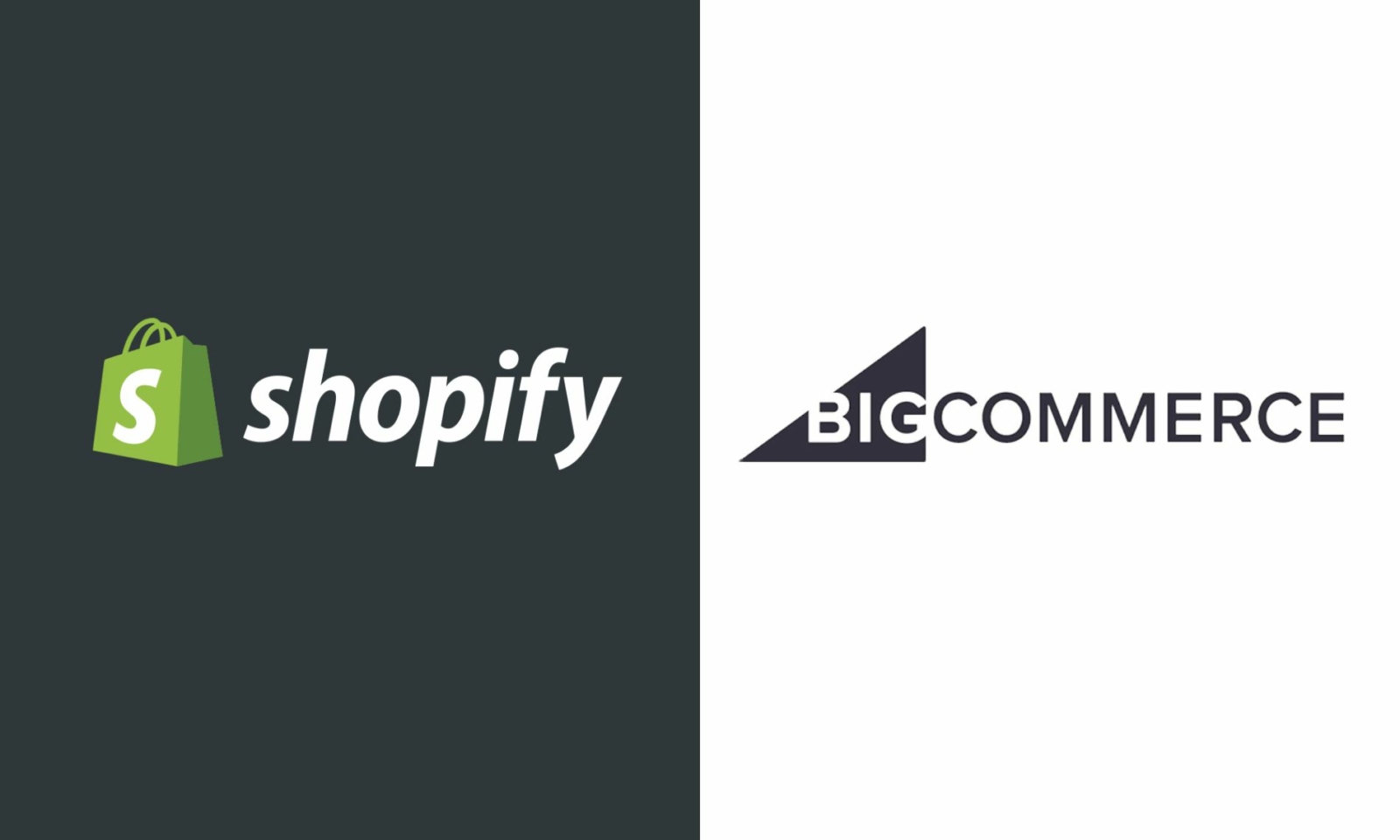When it comes to choosing an ecommerce platform, Shopify and BigCommerce are two stand-out options, and leading choices for businesses looking to grow their online store.
Both platforms offer a wide array of features and tools, but which comes out on top? In this detailed comparison, we’ll delve into the key aspects including pricing, performance, scalability and design to help you decide which is for you.
BigCommerce
BigCommerce is an all-in-one ecommerce platform with a comprehensive set of built-in features, offering merchants the flexibility to create customisable, fully responsive websites. BigCommerce provides all of the essentials that an ecommerce business needs to thrive, from inventory management tools to secure payment processing.
Key stats:
Active stores: 43,533 (BuiltWith)
Average conversion rate: 1.9% (BigCommerce)
Notable users: Ben & Jerry’s Ice Cream, Toyota, Gillette
Key features:
- Multi-stores from one account
- Fully hosted
- Built-in tools
- 24/7 support
Shopify
Shopify is a big-name in ecommerce, and for good reason. It’s a specialist ecommerce platform, designed to make the process of building an online store as simple as possible. It’s an all-in-one solution allowing merchants to start, run and grow an online business, all from one user-friendly dashboard. Shopify’s POS system also makes running an omni-channel commerce business a lot simpler by streamlining online and in-store processes.
Key stats:
Active stores: 4.5 million (BuiltWith)
Average conversion rate: 1.4% (Shopify)
Notable users: Gymshark, Kylie Cosmetics & Heinz
Key features:
- Dedicated app store
- User-friendly interface
- Fully hosted
- 24/7 customer support
Cost & value for money
Shopify: the pros
All-in-one pricing: Shopify’s monthly plans cover hosting, security, and support. It simplifies budgeting as you know what to expect each month.
Free trial: Shopify offers a 14-day free trial, allowing you to explore the platform before committing.
Tiered pricing system: Shopify offers four different pricing plans: Basic, Standard, Advanced and Plus. This means you can keep your costs low in the beginning, and upgrade as your business grows, so your Shopify store grows with you which alleviates some of the worries around cost.
Shopify: the cons
Transaction fees: while Shopify Payments offers 0% transaction fees, using external payment gateways may incur additional costs.
Add-on costs: additional apps and features may require separate payments, potentially increasing overall costs.
BigCommerce: the pros
All-in-one-pricing: Like Shopify, one of the perks of BigCommerce is that it’s a fully hosted platform, saving you money and keeping everything in one place.
No transaction fees: no transaction fees on any plan – applies no matter what system is used to process card transactions.
Custom pricing system: BigCommerce offers tailored pricing for enterprise level businesses, suited to each merchant’s sales. This means the price only increases when your business grows.
Built-in features: BigCommerce has more built-in features, keeping additional costs on third party integrations down.
BigCommerce: the cons
Lack of transparency: while tailored pricing has its perks, it also creates a lack of transparency when trying to choose the right platform.
Our winner: Shopify
Development & design
Shopify: the pros
User-friendly interface: Shopify is renowned for its user-friendly interface. It’s designed to be intuitive, allowing users with little to no technical expertise to set up and customise their online stores easily. This can be advantageous for merchants who prioritise simplicity in design and want a quick and hassle-free website setup.
Professionally designed themes: Shopify offers a wide range of themes (12 free), many of which are created by experienced designers. These themes are visually appealing and cover various industries, making it easy for users to find a storefront that aligns with their brand and style preferences.
Easy-to-use store editor: while both Shopify and BigCommerce have drag-and-drop store editors. But Shopify’s intuitive “sections” make it easier to edit, show, hide and rearrange specific sections of a page to create the optimal shopping experience for customers without design or coding experience.
Unified design: while other ecommerce platforms allow you to sell on multiple platforms, none make it as easy as Shopify does to have a unified design across all of them. Shopify allows you to manage all channels from one dashboard, keeping your brand aesthetic consistent no matter where your customers find you.
Liquid template language: for those with coding experience or access to a developer, Shopify has its own template language called Liquid. This gives users the option to create more bespoke website designs with less limitations.
Shopify: the cons
Cost: Shopify’s premium pre-built themes come at a cost, ranging from $140-$350. This means that the majority of Shopify’s better templates are quite pricey, with only 12 free themes available at present. Some of the customisation options, such as modifying the store’s checkout pages, are only available with Shopify Plus, which is considerably more expensive than other plans.
BigCommerce: the pros
Wide range of themes: BigCommerce also offers 12 free themes. A further 150 paid themes are also available.
Mobile responsiveness: All pre-built BigCommerce themes are mobile responsive and optimised for all devices.
Comprehensive design tools: BigCommerce comes with a handy set of design tools, including HTML/CSS and Stencil framework access, allowing for more advanced customisation options for those with coding skills.
BigCommerce: the cons
Not beginner friendly: while BigCommerce has the capability for advanced customisation, it’s generally harder to achieve unless you have coding knowledge or access to a skilled developer.
Steep learning curve: BigCommerce uses the Handlebars template language which opens up more customisation options, but may require a steeper learning curve than Shopify’s Liquid.
Less intuitive: the design and build process when creating a BigCommerce store is less intuitive than its competitors.
Our winner: Shopify
Performance & scalability
Shopify: the pros
Sales channel integrations: Shopify offers a growing list of integrations and partnerships to allow you to sell on your customers’ preferred sales channels. The Shopify ecosystem is extensive, with Facebook, Instagram, Amazon, TikTik and Pinterest integrations available.
Built for growth: Shopify is designed to grow with your business. The tiered pricing structure offers a platform built for ecommerce businesses at every stage of business growth, from startup to enterprise, without ever having to migrate to another platform.
International selling capabilities: Shopify merchants have access to Shopify Markets, which is a cross-border management tool that helps you launch and manage your business across borders from one single store. This makes expanding into new territories easier, and can also increase conversions by offering a localised browsing experience thanks to language translations and currency conversions.
Innovative payment gateways: Shopify has its own payment gateway, Shopify Payments, which is available in 22 countries and supports most major payment options with 0% transaction fees. With it, you can enable Shop Pay, which is an accelerated checkout option, allowing customers to opt in to have their information prefilled at the checkout, making online checkout 4x faster.
Performance optimisation: Shopify takes care of performance optimisation, ensuring that your store remains fast and responsive. However, it’s worth noting that using complicated themes or installing too many third party apps can slow your site down, but Shopify recently made it easier than ever to keep on top of Core Web Vitals with the introduction of the Web Performance Dashboard.
Shopify: the cons
Limited customisation for high-end stores: while Shopify is scalable, the level of customisation might not satisfy the needs of extremely large or complex ecommerce operations. However, Shopify Plus is catered to enterprise level businesses, so this isn’t too much of an issue as long as you have the budget for the premium pricing structure.
BigCommerce: the pros
Advanced product options: BigCommerce is built to grow with your business, with up to 600 SKUs per product and 250 options.
Performance optimisation: BigCommerce delivers fast loading online stores that are built to handle high volumes of traffic.
Scalable features: BigCommerce provides a range of features that help with the scalability and performance of your online store. These features include flexible pricing rules and inventory management tools.
Single page checkout: BigCommerce speeds up the checkout process by keeping it down to a single step.
BigCommerce: the cons
Product filtering limitations: custom product filtering is only available on higher tier plans, placing limitations on smaller businesses.
Annual revenue limits: BigCommerce places annual limitations on revenue. This means that you can only stay on your chosen plan if you earn below the annual revenue cap.
Our winner: Shopify
Apps & integrations
Shopify: the pros
Thousands of apps: The Shopify app store contains over 6000 apps (over 3000 are free), to customise Shopify to meet your unique needs.
POS system: Shopify has a fully integrated point-of-sale solution that lets you connect offline and online sales in a single place, with built-in in-store pickup and local delivery options, tipping, and other must-have functionality for retail stores.
Ease of integration: installing and integrating apps in Shopify is typically straightforward. The platform is designed to be user-friendly, and many apps can be added with just a few clicks
Quality assurance: since all apps go through a review process before being listed on the Shopify App Store, users can expect a certain level of quality and security from the available plugins.
Centralised management: apps can be managed and configured within the Shopify dashboard, providing a centralised location for users to control and monitor their store’s functionalities.
Shopify: the cons
Costs add up: while some apps are free, many come with subscription fees. The costs of using multiple apps can add up, potentially increasing the overall expenses for store owners.
Limited customisation: users might encounter limitations in terms of customisation when relying solely on third-party apps. Customising functionalities beyond what the apps offer may require advanced development skills.
Dependency on app developers: the effectiveness of apps depends on the developers’ commitment to updates and support. If an app developer discontinues support or updates, it could lead to compatibility issues or security vulnerabilities.
BigCommerce: the pros
Range of apps: BigCommerce’s app store offers a solid selection of integrations across marketing, analytics, shipping, payment gateways and more. There’s a mix of free and paid apps which cater to a variety of business needs.
Quality standards: BigCommerce maintains quality standards for its apps, ensuring they are reliable and secure.
Seamless integrations: BigCommerce enables seamless integrations with popular services and platforms, such as Facebook, Google Analytics, PayPal, UPS and USPS.
BigCommerce: the cons
Less variety: While the BigCommerce app store covers the main areas of running an ecommerce store, it lacks the variety that the Shopify store offers, which may place limitations on the functionality of your website.
Less options for physical stores: While BigCommerce does integrate with many of the same third party POS systems as Shopify, it primarily focuses on the online store, meaning that merchants operating a retail and ecommerce store may find that the POS features are lacking.
Our winner: Shopify
Which is better: Shopify of BigCommerce?
Shopify and BigCommerce both offer competitive pricing, excellent performance, scalability and customisable design options. But when comparing key features side by side, Shopify is the clear winner in our eyes. The options for adding bespoke functionality are unparalleled thanks to the Shopify app store, and design updates are straightforward even if you’re a total novice thanks to the user-friendly page builder.
Thinking about making the move to Shopify? We can handle your BigCommerce to Shopify migration from design to launch – send us a message to get started.

